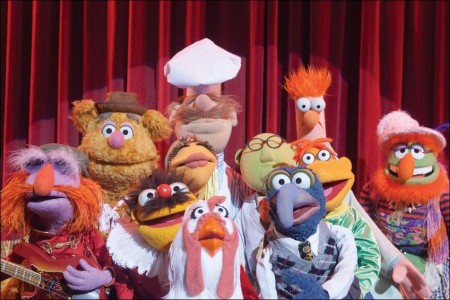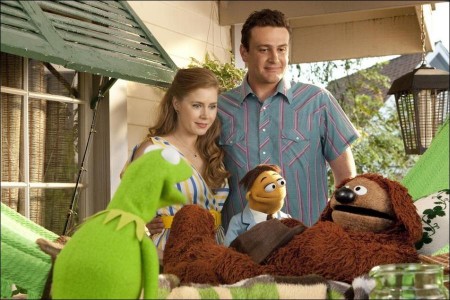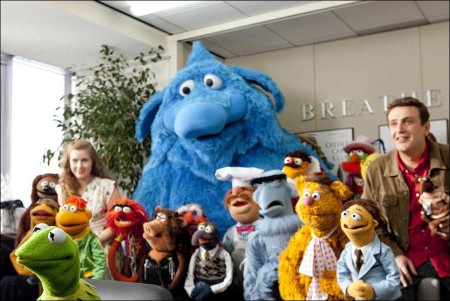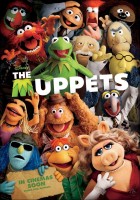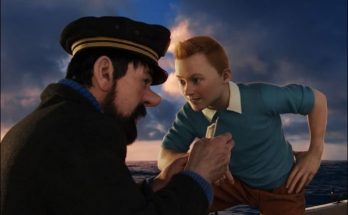On vacation in Los Angeles, Walter, the world’s biggest Muppet fan, and his friends Gary (Jason Segel) and Mary (Amy Adams) from Smalltown, USA, discover the nefarious plan of oilman Tex Richman (Chris Cooper) to raze the Muppet Theater and drill for the oil recently discovered beneath the Muppets’ former stomping grounds.
To stage The Greatest Muppet Telethon Ever and raise the $10 million needed to save the theater, Walter, Mary and Gary help Kermit reunite the Muppets, who have all gone their separate ways: Fozzie now performs with a Reno casino tribute band called the Moopets, Miss Piggy is a plus-size fashion editor at Vogue Paris, Animal is in a Santa Barbara clinic for anger management, and Gonzo is a high-powered plumbing magnate…
Muppet Fans Unite
Ranging in age from 8 to 80, Muppet fans span the globe. So it makes sense that Disney’s “The Muppets” was ignited by a Muppet fan. “It started when I was a kid,” says Jason Segel. “The Muppets were my first comic influence and I was in love with puppetry. I just thought it was an amazing art form.”
“All comedy writers are Muppet fans,” adds Nicholas Stoller. “It’s the gateway to comedy. It’s like the first thing you try and then you slowly fall down the rabbit hole of comedy.”
A film Segel and Stoller previously collaborated on actually set things in motion, says Segel. “We ended ‘Forgetting Sarah Marshall’ with a lavish puppet musical, and The Jim Henson Company designed the puppets. Something started growing in my belly, and Nick and I came up with this idea and pitched it to Disney. Disney liked the idea so we wrote the script.”
Enter producers David Hoberman and Todd Lieberman—each with their own affinity to all things Muppets. “I think there’s always been a timeless quality to the Muppets,” says Hoberman, who cites the Muppets’ recent online smash viral video “Bohemian Rhapsody.” “These characters are as contemporary today as they were when Henson first brought them to life. I think people of all ages will respond to them on the big screen.”
While president of the motion picture group at The Walt Disney Studios, Hoberman was behind releases like “The Muppet Christmas Carol” and “Muppet Treasure Island.” Meanwhile, Lieberman’s appreciation for the franchise grew from personal experience. “I have always been a big Muppet fan,” says Lieberman. “There’s clearly a nostalgic love. The characters are just inherently lovable and I’m thrilled that we’re bringing them together again in this movie. It’s been beautiful introducing them to my own children.”
And that’s a good thing, says director James Bobin. Disney’s “The Muppets” will welcome a whole new generation into the world of the Muppets, and Bobin can attest to the positive influence these characters can have on young audiences. “I watched the Muppets at a very early age in England, and they have significantly influenced my sense of humor and what I find funny.”
Segel says it’s the Muppets’ sense of humor that differentiates them. “Modern comedy makes jokes at other people’s expense,” says the actor, writer and executive producer. “The Muppets never make fun of anybody. They’re all about being good and nice and trying to make the world a better place. It’s easy to get a laugh out of making fun of somebody, but the Muppets never relied on that.”
Introducing Walter
Influenced by their affinity for Muppet mayhem, filmmakers introduced a central character who’s driven by his lifelong love of the Muppets. According to Jason Segel, Walter’s wildest fantasy is to meet the Muppets. “Walter is naive, sweet, innocent, wide-eyed—he’s very much like Kermit before Kermit became famous,” says Segel. “But he just wants to belong. The Muppets are the only people he’s ever seen who were like him, so his quest is to become one of the Muppets.”
Adds Walter, who is as big a Muppet fan in real life as his character is, “I start out just wanting to meet the Muppets but then have to help Kermit get the gang back together to save Muppet Studios. It’s the role of my lifetime. In fact, it is my life.”
The movie opens in Smalltown, USA, home to Walter, brother Gary and his girlfriend, Mary. It’s the kind of town where people smile a lot, give apples to teachers and break into song—just because. But the trio leaves the safety of Smalltown behind for a long-awaited trip to Hollywood—and an opportunity to visit Muppet Studios at last.
While there Walter overhears the evil plan of nefarious oil baron Tex Richman and finds himself navigating a long-awaited, never-imagined, can’t-believe-it’s-really-happening-to-me Muppet reunion. It’s not long before the world’s biggest Muppet fan is face to face with the heart of the Muppets—Kermit the Frog. “Kermit is my all-time hero,” says Walter. “I have his poster in my room, I’ve seen everything he has ever done and meeting him was the greatest moment of my life.”
Segel can certainly relate to Walter’s enthusiasm, but his character, Gary, shows a little too much interest in his brother’s Muppet dreams. His girlfriend Mary has her own California dreams, it turns out, and is secretly hoping for a marriage proposal during their vacation. But she is a team player and willingly jumps on board to help reunite the Muppets and save the studio.
They track down Kermit and learn that he’s lived a quiet life since the Muppets last performed together. It takes some convincing to get the now low-key frog to agree to the plan, but once Kermit realizes just how much he misses his friends, it’s “go” time.
“They embark on a huge journey around the world to find the rest of the Muppets who have gone their separate ways,” says Bobin. “The first Muppet they find is Fozzie, who’s performing with a Muppet tribute band called the Moopets. The Moopets are cynical characters who are taking advantage of the Muppets’ legacy. They sing tacky versions of their songs and sadly, Fozzie is the only real Muppet who joined up with them. He’s in a tribute band of his own group. It doesn’t take too much persuading to get Fozzie to come along for the ride.”
Next up is Gonzo, who has left show business behind in favor of his first career choice: plumbing. He is to plumbing what Tex Richman is to oil—minus the evil-villain part. But Gonzo’s plumbing empire is no match for the lure of the stage, and he soon agrees to return to Muppet Studios and his daredevil act.
Perhaps the trickiest piece to the Muppet reunion is Miss Piggy, who’s landed a posh gig in France as plus-size editor of Vogue Paris. She’s enjoying the big life and doesn’t exactly dream of reuniting with the Muppets—unless, of course, it’s Kermie who’s asking. But it’s not all romance between them, says Miss Piggy. “The scene where Kermie begs me to come back to Hollywood with him is the funniest scene in the movie,” she says. “I’m hilarious, and the frog isn’t half bad either.”
Back together at last, the Muppets must put together the best show of their lives—no small feat considering their past efforts. And it’s been years since they last performed—rusty doesn’t begin to describe their acts. Can they break through the obstacles and create a show of a lifetime? Can they convince a network to broadcast the show? Will they raise enough money to silence Tex Richman once and for all—or will he foil their efforts and destroy the studio despite everything?
Action
There are many advantages to shooting a movie in Southern California. “Horray for Hollywood,” says Kermit. “It was great to shoot so close to home. We saw so many friends…and put most of them in the movie.”
“The actors and celebrities who wanted to be a part of this experience were tremendous,” says producer Todd Lieberman. “There are going to be great surprises and many recognizable faces with really funny roles.”
Jason Segel topped the list of stars who wanted to work with the Muppets. Says Lieberman, “Jason was super passionate about the Muppets and a massive fan. He was the spark.”
The star was so passionate about the project, he not only helped write the script, he wrote a part for himself—a part that required him to sing, dance and act opposite some of the most iconic characters in the world. “In the finale of the movie there are 200 extras, 100 dancers and 50 Muppets,” says Segel. “It was very surreal and it happened to take place on my birthday. I walked out from my trailer thinking I was coming to film, and everyone sang ‘Happy Birthday,’ including the Muppets. I kept thinking, ‘I’ve tricked everyone. Somehow I’ve made this weird childhood dream come true.’ It was the craziest thing ever.”
Filmmakers called on Amy Adams, Chris Cooper and Rashida Jones to round out the main human cast. “Amy Adams plays Mary, Gary’s love interest,” says producer David Hoberman. “She’s a school shop teacher in Smalltown. We thought Amy was just a perfect Smalltown girl. She is also a Muppet fan.”
“I was really into the Muppet movies, the TV shows, the songs,” says Adams. “It’s like every kid’s dream—when you’re playing with your stuffed animals, you wish they’d come to life and talk to you. And now, the Muppets are real. It’s so great to have that physical presence in front of you.”
Cooper’s portrayal of villain Tex Richman will surprise audiences, say filmmakers. “Chris is a fantastic Oscar®-winning actor,” says director James Bobin. “He brings a great level of weight to the role and I really wanted the villain in this movie to feel like a genuine threat to the Muppets. It’s a difficult balance for Chris because he has to be the villain and have fun with it at the same time. He has moments of levity and moments of being serious.”
Cooper says he wanted to be in the film to showcase his hidden talents—and his affinity for his co-stars. “I wanted to sing and dance in a film! And, of course, to act with the Muppets.”
Jones feels the same way. “I feel like I’m in really good company—I really do think the Muppets are timeless. And besides being with the Muppets, it’s just cool to be in a movie with Jason Segel, Amy Adams and Chris Cooper. Give me a break. That’s so cool!”
No Small Feet
It’s time to play the music…it’s time to light the lights… The Muppets have long been known for their big musical numbers, so filmmakers made sure that Disney’s “The Muppets” not only maintained the tradition but hit it out of the park. Both original songs and classic audience favorites are featured in the film, designed to maximize the fun and envelop audiences in the best of Muppet mayhem.
Bret McKenzie serves as music supervisor for Disney’s “The Muppets.” “I know Bret from ‘Flight of the Conchords,’ says director James Bobin. “We used to watch ‘The Muppet Show’ quite a lot when we were writing ‘The Conchords’ together. We’d watch ‘Mah Na Mah Na’ and ‘Hugga Wugga’ during breaks. In one of our ‘Conchords’ episodes, we even included a Muppets tribute. So we love the Muppets. We thought about songs from the previous movies and how that would feel now. We thought about Jason and Amy—Jason’s a good singer and has some moves, and Amy’s obviously a fantastic singer and dancer. The music is incredibly important because of the rich tradition of Muppet music.”
“Music was always an integral part of the original Muppet show and Muppet films,” adds McKenzie. “It’s hard to think of the Muppets without thinking of songs like ‘Rainbow Connection’ or ‘Mah Na Mah Na,’ or Animal smashing a drum. Kermit is probably the world’s most famous banjo player. I loved the original Muppets sound and I wanted this film to stay in that world. I tried to use as much banjo as possible.”
Score
Christophe Beck was called on to create the score for Disney’s “The Muppets.” “My job is to help tell the story musically, providing a sort of emotional glue,” says Beck. “I had to pay special attention to blending the many styles of music so that it felt cohesive.”
Like McKenzie, Beck recognized the importance of music in Muppet history. “‘Rainbow Connection’ has essentially been synonymous with the Muppets since the first movie in 1979,” says the composer. “But there is a rich tradition of scores there too: Hans Zimmer and Michael Giacchino have scored Muppets movies. Part of the tradition is that the music takes the Muppet characters seriously, treating them like real people with real emotions and conflicts.”
Beck utilized a full orchestra to express the breadth of emotion on screen. “To give things more character, I featured some solo orchestra instruments I feel are typically underused—tuba, cimbasso, timpani and bass clarinet, among others. I also found spots to use nonorchestral instruments—Kermit plays the banjo, after all—to bring more personality into the music and make it feel more tailored to the Muppets.”
Song and Dance
McKenzie penned the opening and finale song titled “Life’s a Happy Song,” performed by Jason Segel, Walter and Amy Adams. “I wrote this in New Zealand when I was in a particularly good mood,” says McKenzie. “I sat down at the piano and it came out very quickly. It’s a simple little song and James Bobin really liked it. He then asked me to make it into a gigantic musical number involving an entire town singing and dancing. That took the rest of the year. One of the highlights of the job was watching an orchestra play this song for the final score. I had, only a few months earlier, been sitting at home playing it on my piano and suddenly there was an entire orchestra playing my song. That was a magical moment.”
“‘Life’s a Happy Song’ starts off with Gary and Walter while they’re brushing their teeth,” says producer David Hoberman. “They make their way outside and into Smalltown, USA, along the way picking up people who sing and dance along with them—the butcher, the baker, the milkman, the flower-shop keeper—everybody gets involved. It’s one of those musical numbers that hearkens back to the old movie musicals of the ’50s.”
The film tapped 60 dancers for the opening musical performance, and veteran choreographer Michael Rooney, son of Hollywood film legend Mickey Rooney (who performs a cameo in the film), stepped in to work his magic. “Michael choreographed all the dance numbers,” says Hoberman. “He has amazing energy; he’s really creative and very nimble.”
Rooney says that the choreography came with its challenges as Muppets are typically shot from the waist up. “All my choreography had to be for them—Miss Piggy, Kermit, Walter and the rest—incorporating more of the hand [movements] above their waists because most of the footwork would not be seen.”
McKenzie also wrote a song called “Man or Muppet.” “It’s a power ballad that deals with a man/Muppet identity crisis,” he says. “We’ve all been there. I hammered it out on the piano, imagining I was Harry Nilsson or Eric Carmen.”
The music supervisor says the song required strong vocal performances from both Jason Segel and Walter. “Luckily, they did an amazing job,” says McKenzie, who also wrote a song with Ali Dee called “Let’s Talk About Me” for Chris Cooper. “Turns out he’s dangerous on the mic,” says McKenzie of the actor.
Not to be outdone, Amy Adams and Miss Piggy teamed up for a duet created by McKenzie called “Me Party.” “It needed to be sad but also up-tempo, so I came up with a party track for the lonely. I wrote this song sitting in a cafe, drinking iced teas and getting weird looks from the waitress when I did Miss Piggy impressions. Amy Adams did a great job of channeling her inner disco diva. Miss Piggy was predictably difficult to work with; I think she was dealing with some personal issues.”
Also featured in the film is the original song “Pictures In My Head,” performed by Kermit the Frog, Fozzie, Gonzo, Swedish Chef, Dr. Teeth and the Electric Mayhem, and written by Jeannie Lurie, Aris Archontis and Chen Neeman. Andrew Bird is the writer/artist behind the song “The Whistling Caruso,” a song performed by newcomer Walter in the movie.
While the new songs are sure to please, no Muppet movie would be complete without some signature songs. Disney’s “The Muppets” features “Rainbow Connection,” written by Paul Williams and Kenny Asher, performed by Kermit the Frog and The Muppets, and, of course, “Mah Na Mah Na,” featuring Mahna Mahna and The Snowths. And, of course, a Muppet movie wouldn’t be complete without covering classic rock songs and contemporary favorites. The Muppet Barbershop Quartet has taken on Nirvana’s classic “Smells Like Teen Spirit,” while Camilla and the Chickens cluck their way through Cee Lo Green’s hit “Forget You.”
“The Muppets don’t sound like anyone else,” says McKenzie, “and that’s what’s great about them. It was a huge honor to work on the [film] and I took the job very seriously, even when I was recording a man pretending to be a penguin.”
“Life’s a Happy Song” returns for the film’s finale scene, which shut down Hollywood Boulevard for two evenings. “We had 80 dancers and 300 extras,” says Rooney. “It was huge, amazing and fabulous. I think the audience is really going to be blown away once they see it.”
Kermit agrees. “I love the finale,” he says. “It’s got everyone in it—Jason, Amy, Walter and all the Muppets. I don’t want to spoil the movie, but I think it’s a very happy ending.”
From Walt Disney Records, the soundtrack for Disney’s “The Muppets” hits stores and at online retailers Nov. 21, 2011, including:
· “The Muppet Show Theme”—The Muppets
· “Life’s a Happy Song”—Jason Segel, Amy Adams, Walter
· “Pictures in My Head”—Kermit, The Muppets
· “Me and Julio Down by the Schoolyard”—Paul Simon
· “Rainbow Connection (Moopets Version)”—The Moopets
· “We Built This City”—Starship · “Me Party”—Miss Piggy, Amy Adams
· “Let’s Talk About Me”—Chris Cooper, Nathan Pacheco
· “Man or Muppet”—Jason Segel, Walter
· ”Smells Like Teen Spirit”—The Muppet Barbershop Quartet: Rowlf, Beaker, Link Hogthrob and Sam Eagle
· “Forget You”—Camilla and the Chickens
· “Rainbow Connection”—The Muppets
· “The Whistling Caruso”—Andrew Bird
· “Life’s a Happy Song Finale”—Entire Cast
· “Mah Na Mah Na”—Mahna Mahna and The Snowths
Making Mayhem
When A-listers Kermit, Miss Piggy and the rest of the Muppets decided to return to the big screen after 12 years—much to the delight of their fans—filmmakers knew that the glitz and glamour of Hollywood would be the perfect setting for the film. Disney’s “The Muppets” shot on location in and around Los Angeles as well as at some legendary Hollywood landmarks, including Grauman’s Chinese Theater, Canter’s Deli, Greystone Mansion and Pink’s Hotdogs.
It’s not easy being green and it’s not easy creating the world of the Muppets either. Just ask production designer Steve Saklad. “We found that Muppets come to life in certain kinds of worlds and go flat in other kinds of worlds.”
Saklad did extensive research into the original set and props from “The Muppet Show.” “We arrived at an aesthetic that had a period sense to it even when we’re doing contemporary work,” he says. “We have this great sense of history in every scene.”
And when it comes to creating the backdrop for Muppets, color is key, says the production designer. “We have main actors who are green and blue and pink and orange, so we were able to step things up to a richer red, a richer gold, a richer lavender.”
The film begins at the home of Gary and Walter in Smalltown, USA. According to Saklad, their house has a retro feel to it but nothing era-specific was used to convey the idea that the film could be taking place at any point in time. Since the story revolves around a trip to Los Angeles, Saklad decorated Gary and Walter’s home with travel-themed rooms. There was airplane wallpaper in the bedroom, sailboat wallpaper in the bathroom, and a wide assortment of model airplanes, trains and rocket ships throughout their home. There were also several pictures on the walls dating back to their early childhood.
Saklad themed Smalltown with 1950s Norman Rockwell in mind, lining the streets with mom-and-pop shops, like a butcher shop, a flower shop, a drug store, plus a host of American flags. The old-school Americana theme extends to the props on shop teacher Mary’s desk. “When we first meet Mary in her school, there’s a row of 18 apples marching across her school desk—one for each of her students.”
Hollywood’s grittier surroundings are a far cry from Smalltown, but Saklad found the perfect location for Muppet Studios. “We actually shot at the Jim Henson Company headquarters on the historic Charlie Chaplin lot, so it has this great history to it.”
The story called for a run-down look for Muppet Studios, so the set design incorporated rust, cobwebs and a lot of wear and tear. A sign at the entrance proclaims a series of tour attractions and their sad fates: Fozzie’s Joke Room, “Closed”; Gonzo’s Cannonade, “Closed for Repair”; Rowlf’s Music Parlor, “Under Renovation”; Dr. Honeydew’s Laboratory of Fun, “Out of Order.”
According to Saklad, Kermit’s office offers a glimpse back in time to his heyday. “It’s inspired by Brian Henson’s office,” says Saklad. “We also incorporated the 1915 Charlie Chaplin–era architecture.”
Saklad’s team mounted a collection of Kermit-inspired banjos on the wall as well as a treasure trove of Muppetabilia. A small exit door is seen within the desk alcove, modeled after the one actually found in Jim Henson’s office. A leaded monogram in the stained glass bay window reads “K F” for Kermit the Frog. Decorating the office are two well-worn megaphones from the Cecil B. DeMille era, a mini-tuxedo on a silent butler, Underwood typewriters, Rolodexes and a framed blowup of an antique postcard to remind Kermit of his swamp from the first Muppets movie.
The exterior of Kermit’s mansion was filmed at a private residence in Encino, while the interior of the mansion was filmed at the famous Greystone Mansion. Greystone, which is now in operation as a park in Beverly Hills, was once the home to the Doheny family, who coincidentally made their fortune in oil.
Miss Piggy’s Vogue Paris office was shot inside the Pink Palace mansion in Bel Air. Saklad’s team incorporated elaborate draperies and ornate furnishings.
One of the biggest and most important undertakings of the set design was recreating the Muppet Theater. Saklad studied images from “The Muppet Show” as well as iconic theaters on Broadway. The Muppet Theater was built into the original “Phantom of the Opera” theater set from the 1920s film, located on the Universal Studios lot. The set is now on the National Historic Register, so Saklad and his team had to get approval to turn it into the Muppet Theater set.
The film’s big finale performance was shot on Hollywood Boulevard, just outside of the famous El Capitan Theatre. Coincidentally, part of the scene was shot under a lamppost banner with a picture of a grinning Jim Henson looking down onto the street below. Says executive producer Martin G. Baker, “I feel there’s a little bit of Jim in a lot of us, and somehow collectively, we’re able to keep the spirit of what the Muppets are all about.”
The Muppets
Directed by: James Bobin
Starring: Kermit the Frog, Miss Piggy, Jason Segel, Amy Adams, Chris Cooper, Rashida Jones, Ken Jeong, Zach Galifianakis
Screenplay by: Jason Segel, Nick Stoller
Production Design by: Steve Saklad
Cinematography by: Don Burgess
Film Editing by: James Thomas
Costume Design by: Rahel Afiley
Set Decoration by: Tracey A. Doyle
Art Direction by: Andrew Max Cahn
Music by: Christophe Beck
MPAA Rating: PG for some mild rude humor.
Studio: Walt Disney Pictures
Release Date: November 23, 2011
Hits: 114
